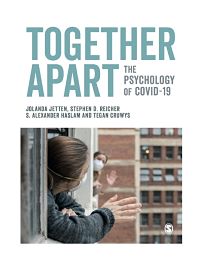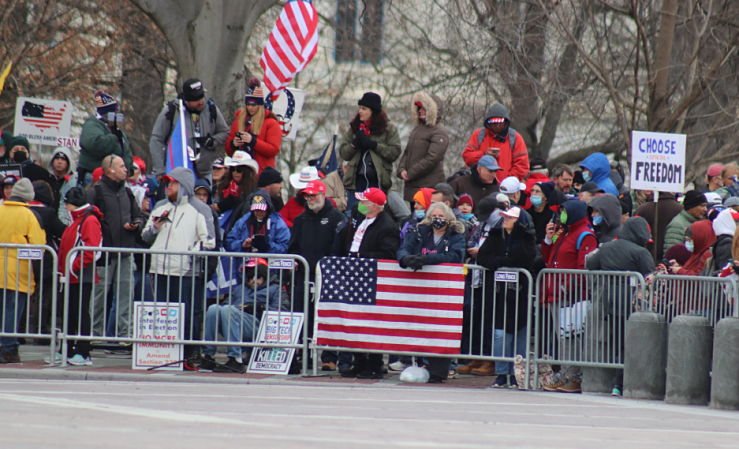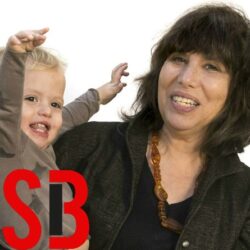Prejudice, Discrimination, and COVID-19: Excerpt from ‘Together Apart’
For the people that are now out of work because of the important and necessary containment policies, for instance the shutting down of hotels, bars and restaurants, money will soon be coming to you! The onslaught of the Chinese Virus is not your fault! Will be stronger than ever! (Donald J. Trump on Twitter; Coleman, 2020)
It’s not racist at all. No, not at all. It comes from China, that’s why. It comes from China. I want to be accurate. (Donald J. Trump, White House Coronavirus Task Force News Briefing; Forgey, 2020)
The COVID-19 pandemic has brought about profound changes in the way individuals around the world conduct themselves in their daily lives. One of the more marked changes is the sudden spike in overt hostility toward those perceived as “outsiders”. In particular, because the spread of COVID-19 started in central China, much of that prejudice has been directed towards the Chinese and, by association, Asians. Indeed, this prejudice has itself spread like a virus around the globe and is particularly evident in the United States. Prior to 2020, President Donald Trump directed his virulent form of nativist politics toward the most vulnerable immigrant group at the time, the Latinx community, calling for a border wall along the U.S.-Mexico border and seeking to deport undocumented migrants from Mexico and other nations in Latin America. However, as the above quotes attest, the COVID-19 pandemic has redirected Trump’s antipathy (and that of his supporters) toward a different racial minority group — Asians.
COVID-19 awakened dormant group-based prejudices
Historically, concerns about contagion have enhanced xenophobia toward foreigners (Rao & Greve Insead, 2018). More generally, fear of the unknown has the capacity not only to inspire new forms of bigotry, but also to foment prejudices that have lain dormant for some time. Especially in times of national distress and uncertainty, outgroups that in better times were viewed in largely positive (albeit rather stereotypical) ways can come to be portrayed in decidedly negative and indeed, sinister terms. In 14th century Europe, Jews were treated as scapegoats for supposedly carrying the black plague that raced from Asia through the Middle East and Europe. Even after the pandemic was over, they were still persecuted on the basis of false claims that they had helped to spread the illness. Consistent with this reasoning, studies have demonstrated that when dominant groups (e.g., white Canadians, men in STEM) are exposed to demographic projections which suggest that they will become a numerical minority, they feel angrier and more fearful of racial minorities (Outten et al., 2012) and less tolerant of these groups (Danbold & Huo, 2017).

The response to COVID-19 in the U.S. provides a clear example of how the sudden onset of acute threat can unleash latent feelings of prejudice. For Asian-Americans, there had been numerous examples of such “prejudice following crisis” in the country’s past. In particular, during World War II, Japanese Americans were forcibly relocated to internment camps by the U.S. government. In recent decades, such blatant discrimination had abated — with attitudes shifting so that Asian-Americans were seen less as threatening outsiders, and instead as a model minority (Takaki, 2012). Yet despite these developmental shifts in sentiment, it took just a few weeks for anti-Asian sentiment to be revived during the COVID-19 crisis.
Similar dynamics can be observed in India. Even though Indian minorities played no part in the spread of the virus into the country, here too minorities have found themselves increasingly under attack. In the context of long-standing conflict between Hindus and Muslims, the majority group Hindus have used the COVID-19 crisis to legitimize prejudice and hostility towards the Muslim minority. For example, Ellis-Petersen and Rahman (2020) report that:
In Mangalore this week, posters started appearing that said Muslims were no longer allowed in certain neighborhoods. “No Muslim trader will be allowed access to our hometown until the coronavirus is completely gone,” read a sign in Alape. In the Hindu-dominated village of Ankanahalli, a video … shows Mahesh, the village panchayat president, issuing a warning that if any Hindu in the village is caught fraternizing with a Muslim “you will be fined 500 to 1,000 rupees”.
The speed with which blatant expressions of prejudice against minorities have re-surged in the context of the COVID-19 pandemic has taken many by surprise. However, closer analysis suggests that the ingredients for hostility were always present. In the case of Asians, the rise in overt prejudice piggy-backed on the myth of the model minority, which was rooted in the view that Asians are high-achieving, hardworking, and accommodating (Fiske et al., 2002). While these attributes are positive, they nevertheless represent stereotypes that overlook individual and subgroup differences within the group (Chao et al., 2013). Moreover, the meaning of these stereotypes can be reshaped in ways that construe them as threats to “ordinary” Americans or Europeans (Oakes et al., 1994). For example, in the context of the massive job losses that have resulted from COVID-19, “high-achieving” and “hardworking” may be framed as a manifestation of Asian-Americans’ desire to out-compete white Americans or Europeans for the limited jobs that remain.
As a result of these resurgent attitudes, the COVID-19 pandemic has separated those with Asian backgrounds from their fellow nationals along a dormant fault-line — this mental division implies that the Asian minority is foreign, or at least less American or European, than whites (Zou & Cheryan, 2017). Indeed, in the U.S., assessments of both explicit and implicit attitudes show that Asian-Americans are viewed not only as less American than other racial groups, but also as less American than whites from other nations (Devos & Banaji, 2005).
This activation of longstanding foreigner stereotypes is consequential. Shortly after President Trump repeatedly referred to COVID-19 as the “Chinese” virus, there was a sudden rise in anti-Asian prejudice and hostility. In the first two weeks of launching a website to track anti-Asian discrimination on March 19, 2020, Asian and Pacific Islander advocacy coalition A3PCON documented over 1000 incidents (Jeung, 2020). These incidents ranged from verbal and physical attacks to subtler bias, such as an emergency physician’s account of noticing people covering their nose and mouth when they passed him in the hospital hallways (Tavernise & Oppel, 2020). Significantly, reports indicate that this hostility was largely directed toward non-Chinese people — highlighting the tendency for people to view Asian-Americans of different ethnicities as interchangeable (Flores & Huo, 2013), which leaves a much larger group vulnerable to race-based attack. In a context that was framed as “them” threatening “us”, the outgroup was large and undifferentiated.
Deviation from a group prototype explains prejudice
To understand these patterns of growing intolerance towards minorities, it is useful to consider how COVID-19 has triggered social identity concerns specific to the dominant groups in society. It is important to consider that, in nations that are diverse in dimensions of race, ethnicity, religion, or language, the dominant group holds not just disproportionate power and status, but also defines the norms of the shared identity against which all members are evaluated. According to the Ingroup Projection Model, all subgroups (including minorities) are evaluated against this norm, and the extent to which they fit the normative expectations of the group (and are thus prototypical of the group) determines their acceptance by the dominant group (Wenzel et al., 2007). The more that a subgroup deviates from the norms of the shared social category, the more negatively they are evaluated. Members of these groups are also denied access to resources, rights, and respectful treatment (Huo, 2002). In contrast, when a group is, in essence, the prototype of the shared social category, its members are evaluated positively. For example, as the most powerful racial group in the U.S., whites are widely regarded as fitting the prototype of Americans (Devos & Banaji, 2005), and they are therefore judged more positively than other racial groups.
Second, in response to perceived threat, the desire among dominant groups to draw the line between who is normative and who is divergent is intensified. The pretext of “being different” from the larger group’s prototype (and thus the norms that the group holds dear) is used as justification for enhanced group-based discrimination and exclusion. Accordingly, in the U.S., when primed with information about their group’s numerical decline, whites report higher levels of prototypicality threat. That is, they become anxious that the association between being white and being American is unravelling (Danbold & Huo, 2015). There is evidence that this threat is experienced by dominant group members as a challenge to their social identity. Specifically, a number of studies demonstrate that a cultural change toward a more complex and inclusive national identity (which potentially challenges the prototype of the group and associated group norms) drives a rise in prejudice and hostility toward immigrants and racial minorities (Danbold & Huo, 2015).
There are reasons to believe that these dynamics have intensified in the face of COVID-19. Here, the resurgence of the “Asians as foreign” stereotype has amplified delineations of who is a “true” American or European (whites) and who is not (Asians). In short, because this minority is seen as falling short of the prototype that characterizes ingroup identity, it becomes easier for members of the dominant group to justify not just feeling negative about its members, but also acting aggressively toward them. “They” are no longer part of “us”. Perhaps “they” never were.
It is a mistake, however, to assume that there is anything natural or inevitable about this process. In particular, as we saw in Section B, leaders play an active and critical role in defining the contours and norms of ingroup identity (Reicher et al., 2019). This means leaders can either legitimize prejudice against groups they define as threats to the ingroup, or else take steps to discredit any such prejudice. During the COVID-19 crisis the former process has been prominent in the U.S., where President Trump provided a lightning rod for the negative feelings that some of his supporters already held toward Asian-Americans.
Nevertheless, other country’s leaders went out of their way to model inclusion. For example, in Australia, Prime Minister Scott Morrison reacted angrily to reports of anti-Chinese hostility by pointing to ways in which Chinese-Australians had been exemplary members of the larger Australian community:
The Chinese-Australian community did an amazing job in those early days of the spread of the coronavirus. They have been an early example to the rest of the country…. They showed all Australians back then how to do this. I want to thank them very, very much for the example they set in those early phases. (Fang et al., 2020)
Rather, then, than portraying minority ingroup members as a prototypicality threat, Morrison portrayed them instead as prototypicality models.
Prejudice harms its targets
The immediate outcomes of enhanced prejudice and discrimination are clear. The experiences of Asians, long stereotyped as “foreign” (at least in Western nations), have shifted from simply being reduced to a model minority to becoming the target of escalating micro-aggressions and even outright hostility. This stigma and discrimination inevitably takes its toll on individuals. Experiences with group-based discrimination are reliably associated with a heightened stress response, both physical and psychological (Haslam et al., 2018; Matheson & Anisman, 2012). This can lead to a cascade of adverse health outcomes, from depression to obesity and cardiovascular disease (Pascoe & Smart Richman, 2009; see also Chapter 17).
The COVID-19 pandemic has enhanced not only xenophobia toward foreigners but also prejudice and hostility toward fellow citizens. It is clear that if this goes unchecked, prejudice and intergroup hostility will ultimately have a corrosive effect on the fabric of society. While there is widespread consensus that we must do everything we can to counter attempts to associate COVID-19 with particular groups of people or places, the key question that remain are not just how to reduce prejudice, but how to work together to build a better society. This is the question that our next, and final, chapter focuses on.
Explore the section of Together Apart on intergroup relations
Prejudice and Discrimination| Yuen J. Huo
Inequality | Jolanda Jetten
Common Identity and Humanity | John F. Dovidio, Elif G. Ikizer, Jonas R. Kunst, & Aharon Levy
Societal Polarization | Charlie R. Crimston & Hema Preya Selvanathan































































































